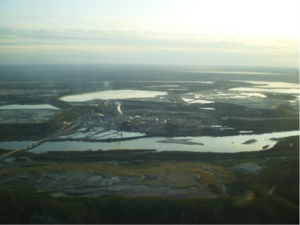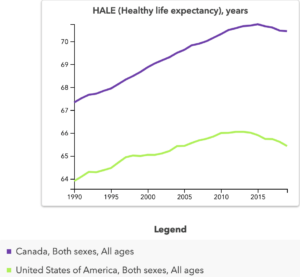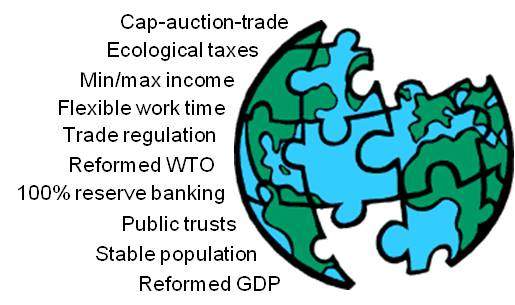Prospecting for a Steady State in North America
by Gregory M. Mikkelson
In late summer of 2001 I moved from the USA to Canada, where my rose-colored glasses paradoxically made the grass look even greener. While President Bush had just reneged on the Kyoto Protocol, Prime Minister Chrétien stood by it, having been one of the first to sign. Two years later Chrétien withstood the pressure to join Bush’s disastrous war against Iraq. Meanwhile, I proudly and gratefully obtained the card entitling me to the universal health care available in Canada but not the USA. And I cherished the fact that wealth, education, and necessities were distributed more equally in my new home.
However, thanks to my work as a professor of environmental studies, my perspective sharpened over time. When a student took part in a cross-country bike tour to raise awareness of the Canadian tar sands industry, it certainly raised my awareness. Mining of bitumen (tar), to be refined into petroleum products, started here in 1967. By 2009 it had turned vast tracts of boreal forest into a Mordor-like landscape, and so badly poisoned the political landscape that a well-known journalist denounced the country as a “thuggish petro-state.” Since then, Canadian tar sands extraction has continued to expand, rather than being quickly phased out as a policy driven by climate science would mandate.

“Witnessing the Tar Sands” (Emily Hunter, CC BY-NC 4.0)
Canada and the USA both degrade the biosphere well out of proportion to the sizes of their respective populations. Their inordinate impacts have much in common, but they also differ in important ways. For example, Canadians and Americans deplete and pollute nature at similarly abhorrent levels through their consumption habits. But Canadian production—and more specifically, extraction—does far more damage on a per-capita basis. Canadian ecosystems, First Nations, and the global climate suffer much of this harm. But disturbing health and social trends point to impacts on non-Indigenous Canadians as well. My home province of Québec offers a bit of inspiration for how Canada and the USA can turn things around.
Environmental Impacts of Consumption vs. Production
Canada and the USA closely resemble each other in their grossly unsustainable consumption. It would take 5.1 Earths to sustain a world population eating as much meat, driving as many miles, heating houses as large, and so on, as the average Canadian or American. And we’d require still more to provide the resources needed for our fellow species to survive. That’s the verdict based on comparing each country’s per-capita ecological footprint against world biocapacity. Ecological footprints measure the area of land and water needed for built structures and the consumption of goods and services using crops, livestock, timber, fish, and/or fossil fuel.
But consumption is only one aspect of life. For most people, production also looms large, as we spend large chunks of our waking lives at work, producing goods or providing services. Regarding the material aspects of production, the two countries diverge. Canada extracts nearly three times as much raw material per capita—66 tons every year—as the USA does (24 tons), and more than five times as much as the world as a whole (13 tons). Moreover, Canada is doubling down on resource extraction at an ever-faster rate. U.S. extraction also continues to increase in toto, but as shown in the figure below, its extraction per capita has declined slightly.

Raw material extraction per capita, Canada and USA (UNEP, International Resource Panel)
Extracted raw materials as discussed here include biomass, metals, other minerals, and fossil fuels. In Canada, fossil fuels is the largest and fastest growing extractive sector, having increased nearly nine-fold in the past half-century. Meanwhile, growth continues in Canada’s other major resource categories. For example, timber companies cut so many Canadian trees that the country’s boreal forest—once a major carbon sink that helped to slow global heating—now emits more carbon dioxide than it absorbs, aggravating the climate impacts of fossil fuel.
Social Impacts of Economic Growth
In our forthcoming book GDP: The Untold Story, we show that economic growth is driving ecological decline, as indicated by 13 indicators of environmental impact. We also show that damage to the natural world is catching up to humanity. GDP growth has worsened health problems from air pollution and obesity, and has aggravated economic inequality, authoritarian government, military spending, and the ongoing mass extinction of languages. If unchecked, economic growth promises to cause societal collapse in the 21st Century.
As noted above, Canada outperforms the USA in distribution of wealth and access to health care. The Gini index of wealth inequality ranges from zero, which indicates perfect equality among households, to 100, which signals maximal inequality; that is, one household owns everything. Canada’s Gini for 2021 (the most recent data) is 74, which is very high, meaning that wealth is distributed very unequally here. However, the USA is even worse, with a Gini index of 83. In both countries—and in most other countries—the gap between rich and poor is widening over time.

Healthy Life Expectancy, Canada and the US, (Institute for Health Metrics and Evaluation)
As might be expected given lesser inequality and universal access to modern medicine, Canada also outperforms the USA in the most comprehensive measure of health, namely health-adjusted life expectancy (HALE). On average, Canadians enjoy five years more of healthy life than Americans do. However, while health had been improving in both countries, both reached a tipping point, with HALE turning downward, even before the onset of COVID-19. Does this portend further declines in the future, if our governments remain obsessed with economic growth rather than the well-being of citizens and nature?
Meeting on the Other Side in Peace
In the early 1970’s, shortly after the Club of Rome first alerted the world to the need for a steady state economy, Gary Snyder published a poem titled “For the Children.” Snyder rued “the steep climb” of growing GDP and its resulting socio-ecological destruction, before holding out the hope that
In the next century
or the one beyond that…
are valleys, pastures,
we can meet there in peace
if we make it.
Neither the Canadian nor the American government offer any hint of helping or even allowing this to happen. But history has shown that social movements sometimes do overcome such intransigence. Moreover, such movements often succeed first at the smaller scales of states, provinces, and municipalities.
How can the steady-state movement bring Canada and the USA into line with Snyder’s vision? Brian Czech pointed out in 2013 that “because the global economy is approximately 90 percent fossil-fueled…capping the extraction of fossil fuels would go a long way toward capping the size of the economy.” In 2021, grassroots organizers in Québec, Canada’s second-largest province, scored a major victory along these lines. They got the government to set a cap on extraction of coal, oil, and gas within the province—at zero!
My home province, while far from perfect, compares favorably to the rest of Canada and the USA in other key respects as well. Québec has the healthiest population of any state or province, and the lowest provincial emissions of greenhouse gas per capita. To boot, it has lower income inequality than the rest of North America. Finally—and with the most obvious relevance to the goal of a sustainable, steady state economy—Québec has a lower GDP per capita, and has grown more slowly, than either Canada or the USA as a whole. Thus, even here, on the most over-consuming continent in the world—and even here, in the fourth-most over-extracting country in the world[1]—Québec provides a model of a relatively steady, low-emitting, egalitarian, and welfare-enhancing economy for the rest of North America to emulate, build upon, and surpass.
[1] Only Australia, Qatar, and Kuwait extract more tons of raw material per capita than Canada does.
Greg M. Mikkelson is CASSE’s Ecological Economist.

 "Rappahannock County Courthouse" by taberandrew is licensed under CC BY-NC 2.0
"Rappahannock County Courthouse" by taberandrew is licensed under CC BY-NC 2.0




Thank you for the good news from Quebec. This article is a nice antidote to so much doom and gloom on the subject. What a potent combination: a grass roots victory to cap extraction and the healthiest population in the lowest GDP province. I can now reflect on past images of a splendid hiking vacation in the areas near Quebec City without the need for rose-colored glasses.
Any discussion of sustainable policies in Quebec related to the environment should include “Hydro-Quebec” – a massive flooding and damming project with proposed transmission lines to the US. Large hydro has been discredited for decades as ‘clean energy’ for multiple reasons. Here is one example: https://www.nrcm.org/news/hydro-quebec-offers-misleading-claims-powers-climate-impact/
PS: I didn’t find the article particularly encouraging
Thank you for this comment Terry, and the well-reasoned op-ed you link to. Both testify to the crucial importance of reducing overall energy use – not just switching from fossil fuel to greener sources.
The example of the Rupert River cited in the op-ed resonates with me, having visited it before it got dammed. Subsequently, a First Nation and a municipality have teamed up to protect another gorgeous river against damming by Hydro Québec, through a rights-of-nature law:
https://theconversation.com/rights-for-nature-how-granting-a-river-personhood-could-help-protect-it-157117
More broadly, yes Québec has a long way to go, both environmentally and socially. But I stand by the evidence cited in the blog, that it already comes closer in certain key respects than most other places in North America do.